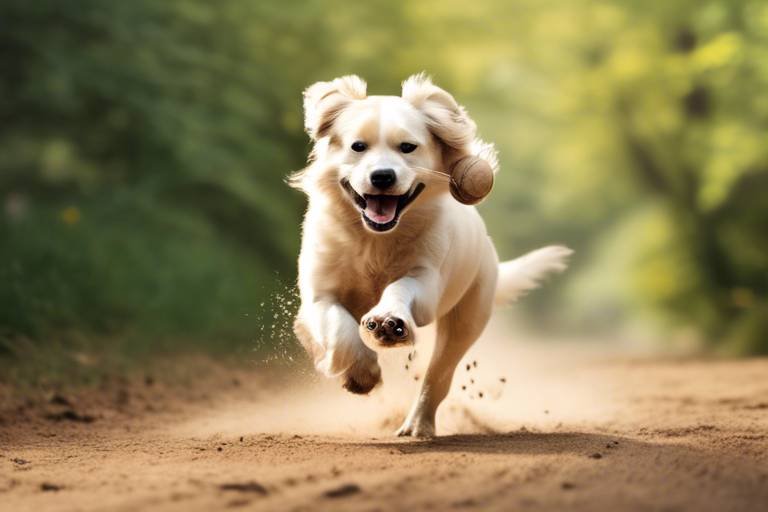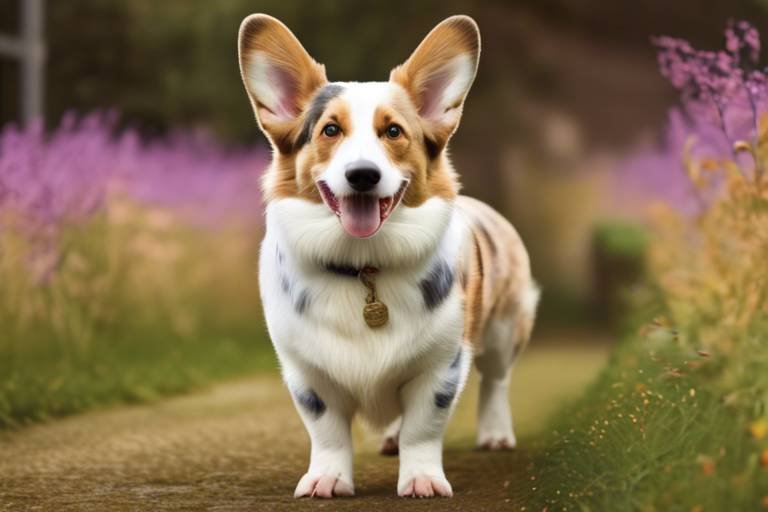How to Identify Common Behavioral Traits by Breed
Understanding your dog's behavior is crucial for fostering a strong bond and ensuring a harmonious household. Just like people, dogs have their own unique personalities, and these traits can be significantly influenced by their breed. In this article, we'll delve into the behavioral characteristics associated with various dog breeds, helping you to better understand your furry friend. By recognizing these traits, you can tailor your training and care strategies to meet your dog's specific needs, ultimately leading to a happier and more fulfilling relationship.
Every dog breed has its own history and purpose, which plays a significant role in shaping its behavior. For instance, herding breeds like Border Collies are known for their intelligence and high energy levels, while toy breeds like Chihuahuas may exhibit more protective behaviors. Understanding these breed-specific behaviors allows owners to anticipate their dog's needs and respond appropriately. This not only enhances the dog's quality of life but also reduces the likelihood of behavioral issues arising due to unmet needs.
Moreover, genetics is a fundamental factor in determining a dog's temperament and behavior. Just as humans inherit traits from their parents, dogs do too. Certain breeds are predisposed to specific personality traits, energy levels, and social interactions. For example, breeds like Labrador Retrievers are typically friendly and outgoing, making them excellent family pets, whereas breeds such as Akitas may be more reserved and protective. By recognizing these inherited traits, owners can better prepare themselves for the challenges and joys that come with their chosen breed.
When considering a dog, it's essential to understand the variations in temperament across different breeds. Some breeds are naturally more active and require extensive exercise, while others are more laid-back and can thrive in a more relaxed environment. For instance, the energetic nature of a Siberian Husky contrasts sharply with the calm demeanor of a Bulldog. Knowing these differences can help potential dog owners select a breed that aligns with their lifestyle and family dynamics.
In addition to temperament, socialization needs can vary significantly between breeds. While some dogs may thrive in social settings and enjoy meeting new people and animals, others may be more introverted and prefer a quieter environment. Early socialization is crucial for all breeds, as it helps them develop into well-adjusted adults. Understanding your dog's socialization needs can significantly impact their behavior and overall happiness.
However, it's important to note that certain breeds are predisposed to specific behavioral issues. For example, breeds like German Shepherds may develop anxiety if not properly socialized, while Terriers can exhibit stubbornness if not adequately trained. Identifying these tendencies early on allows owners to address potential problems proactively, implementing effective training solutions tailored to their dog's unique characteristics. This proactive approach can prevent behavioral issues from escalating and ensure a more enjoyable companionship.
In conclusion, understanding common behavioral traits by breed is essential for any dog owner. By recognizing and respecting the unique characteristics of different breeds, you can create a nurturing environment that caters to your dog's needs. This knowledge not only enhances your relationship with your furry friend but also promotes their well-being and happiness.
- What are the most common behavioral traits associated with specific dog breeds? Different breeds exhibit unique traits; for instance, herding breeds are often energetic and intelligent, while toy breeds may be more protective.
- How can I tailor my training to suit my dog's breed? Understanding your dog's breed-specific traits can help you choose the right training techniques, focusing on positive reinforcement and addressing any behavioral issues early on.
- Why is socialization important for my dog? Early socialization helps dogs become well-adjusted adults, reducing the risk of anxiety and behavioral problems.
- Are some breeds more prone to aggression than others? Yes, certain breeds may have tendencies toward aggression, but understanding their triggers and implementing appropriate training can help manage these behaviors.

Understanding Breed-Specific Behavior
When it comes to our furry friends, understanding their behavior is akin to cracking a secret code. Each dog breed is like a unique book, filled with chapters that tell the story of its history, purpose, and inherent traits. For instance, a Border Collie is a herding breed, designed to work tirelessly on farms, while a Chihuahua is more of a companion breed, bred to be a loving lapdog. These historical contexts shape not just how they look, but how they act. By recognizing these breed-specific behaviors, dog owners can tailor their training and care strategies to create a more harmonious relationship with their pets.
Have you ever wondered why some dogs seem to have endless energy while others prefer lounging on the couch? This difference often stems from their genetic background. For example, breeds like the Greyhound are built for speed and require regular exercise to stay healthy and happy. On the other hand, breeds like the Basset Hound are more laid-back, thriving in a relaxed environment. Understanding these distinctions allows owners to set realistic expectations and provide the right environment for their dogs to flourish.
Moreover, breed-specific behaviors can influence how well a dog interacts with its surroundings. For instance, some breeds are naturally more social and thrive on interaction with both humans and other dogs. Breeds such as Labrador Retrievers and Golden Retrievers are often described as friendly and outgoing, making them great family pets. In contrast, breeds like the Shiba Inu may be more reserved and require a different approach to socialization. Understanding these traits is crucial for fostering positive relationships, ensuring your dog feels secure and understood.
To further illustrate the impact of breed on behavior, consider the following table that outlines some common behavioral traits associated with various breeds:
| Breed | Common Behavioral Traits |
|---|---|
| Border Collie | Highly energetic, intelligent, needs mental stimulation |
| Golden Retriever | Friendly, social, great with families |
| Chihuahua | Loyal, protective, may be wary of strangers |
| Basset Hound | Laid-back, affectionate, enjoys lounging |
| Shiba Inu | Independent, reserved, can be aloof |
In summary, understanding breed-specific behavior is essential for any dog owner. It not only helps in selecting the right breed for your lifestyle but also enriches the bond between you and your pet. By taking the time to learn about your dog's unique traits, you can create a nurturing environment that caters to their needs, ensuring a happy and fulfilling life together. So, the next time you see a dog, remember that their behavior is a window into their history and personality, waiting for you to explore!

The Role of Genetics in Behavior
When we think about our furry friends, it’s easy to focus on their cute faces and wagging tails. However, one of the most crucial aspects that shapes a dog’s personality lies deep within their genetic makeup. Just like humans inherit traits from their parents, dogs do too. This genetic inheritance plays a significant role in determining a dog’s temperament, energy levels, and even their social interactions with other animals and people.
To illustrate this, let’s consider two popular breeds: the Border Collie and the Bulldog. Border Collies are known for their high energy and intelligence, traits that were honed over generations to assist in herding livestock. Their genetics predispose them to be active, alert, and eager to work. On the other hand, Bulldogs are generally more laid-back and relaxed, a reflection of their history as companions rather than working dogs. Understanding these genetic predispositions can help owners set realistic expectations for their pets.
Moreover, genetics can influence not just the behavioral traits we see on the surface, but also underlying temperament issues. For example, certain breeds may have a higher tendency towards anxiety or aggression due to inherited traits. To address these issues effectively, it’s essential for dog owners to recognize the breed-specific tendencies that can arise from genetics. This understanding can guide them in choosing the right training techniques and socialization strategies to ensure a well-adjusted pet.
Here's a quick look at how genetics can influence behavior across different breeds:
| Breed | Common Behavioral Traits |
|---|---|
| Border Collie | High energy, intelligence, herding instinct |
| Bulldog | Calm, relaxed, loyal |
| Golden Retriever | Friendly, social, eager to please |
| Chihuahua | Alert, protective, can be anxious |
In addition to breed-specific traits, the environment in which a dog is raised also interacts with its genetic predispositions. For instance, a Border Collie that is not given enough physical and mental stimulation may develop behavioral issues such as destructiveness or excessive barking. Similarly, a Bulldog raised in a stressful environment may show signs of anxiety even if their breed is typically more relaxed. Thus, genetics and environment work hand in hand to shape a dog’s overall behavior.
In conclusion, understanding the role of genetics in canine behavior is vital for any dog owner. By recognizing inherited traits, owners can tailor their training and care strategies to better meet their dog's needs. This not only fosters a healthier relationship between the owner and the pet but also ensures a happier and more well-adjusted dog.
- Can genetics alone determine a dog's behavior?
While genetics play a significant role, environment and training also greatly influence behavior. - Are certain breeds more prone to behavioral issues?
Yes, some breeds have genetic predispositions to specific behavioral traits. - How can I manage my dog's inherited behavioral traits?
Understanding your dog's breed and providing appropriate training and socialization can help manage their behavior effectively.
Temperament Variations Across Breeds
When it comes to our furry friends, temperament is one of the most defining traits that sets each breed apart. Just like people, dogs have their own personalities, and these personalities can vary significantly depending on their breed. For instance, a Golden Retriever is often known for its friendly and sociable nature, making it a fantastic family pet. On the other hand, a Chihuahua might exhibit a more feisty and protective demeanor, particularly towards its owner. This variation in temperament plays a crucial role in determining how well a breed fits into a particular household or lifestyle.
Understanding these differences is essential for prospective dog owners. For example, working breeds like the German Shepherd or Border Collie are typically high-energy and require consistent mental and physical stimulation. They thrive on tasks and challenges, which can be incredibly fulfilling for both the dog and the owner. In contrast, toy breeds like the Pomeranian or Maltese might be more suited for apartment living, as they generally require less exercise and can adapt to smaller spaces.
Moreover, it's fascinating to note that some breeds are predisposed to be more affectionate and social, while others may be more independent or aloof. For instance, Beagles are known for their friendly disposition, often getting along well with children and other pets. In contrast, Shiba Inus can be quite reserved and may take longer to warm up to new people or environments. This is where understanding the breed's history and original purpose can provide insight into their behavior. A breed developed for herding, like the Australian Shepherd, may have a natural instinct to herd children or other pets, which can be misinterpreted as aggression if not properly managed.
To further illustrate these temperament variations, consider the following table that summarizes some common breeds and their associated temperamental traits:
| Breed | Temperament Traits | Ideal Living Situation |
|---|---|---|
| Golden Retriever | Friendly, Loyal, Intelligent | Active Families |
| German Shepherd | Confident, Courageous, Protective | Active Owners with Experience |
| Beagle | Curious, Friendly, Merry | Families with Children |
| Shiba Inu | Alert, Confident, Independent | Experienced Owners |
| Pomeranian | Playful, Friendly, Intelligent | Apartments or Smaller Homes |
In conclusion, recognizing temperament variations across dog breeds is not just an academic exercise; it's a vital part of responsible dog ownership. By understanding your dog's natural tendencies, you can create a nurturing environment that caters to their unique needs. After all, a well-understood dog is a happy dog, and that happiness translates into a stronger bond between you and your furry companion.
- What are the most common temperament traits in dogs? Temperament traits can include friendliness, aggression, independence, loyalty, and energy levels, which vary from breed to breed.
- How can I determine if a breed is right for my lifestyle? Consider your activity level, living situation, and family dynamics. Research breeds to find one that matches your lifestyle.
- Can a dog's temperament change over time? Yes, a dog's temperament can evolve due to training, socialization, and experiences throughout their life.
Active Breeds vs. Laid-back Breeds
When it comes to choosing a dog, one of the most crucial factors to consider is whether you want an active breed or a laid-back breed. These two categories not only differ in their energy levels but also influence the kind of lifestyle you can expect when bringing a furry friend into your home. Active breeds, like the Border Collie or Australian Shepherd, are often bursting with energy and require significant daily exercise. Imagine having a roommate who is always ready for a run or a game of fetch—if you’re not prepared for that level of activity, you might find yourself overwhelmed!
On the other hand, laid-back breeds, such as the Bulldog or Basset Hound, are more inclined to lounge around the house and enjoy a good nap. They’re perfect for those who prefer a more relaxed lifestyle. However, don’t be fooled—just because they’re laid-back doesn’t mean they don’t need exercise; they still require regular walks and playtime, albeit at a much slower pace. Think of it like choosing between a marathon runner and a couch potato—both have their charms, but their needs are vastly different!
Here’s a quick comparison to help you visualize the differences between active and laid-back breeds:
| Characteristic | Active Breeds | Laid-back Breeds |
|---|---|---|
| Energy Level | High | Low to Moderate |
| Exercise Needs | Extensive (1-2 hours daily) | Moderate (30 minutes to 1 hour daily) |
| Temperament | Playful, Energetic, Alert | Calm, Easygoing, Affectionate |
| Best For | Active families, Outdoor enthusiasts | Apartment dwellers, Less active individuals |
Understanding these differences is essential not just for your dog’s happiness, but for your own sanity. If you lead a busy lifestyle with little time for exercise, opting for a more laid-back breed can save you from the stress of trying to keep up with a high-energy pup. Conversely, if you’re an active individual who enjoys outdoor adventures, an energetic dog can be the perfect companion, keeping you motivated and engaged.
Ultimately, the key is to assess your lifestyle and choose a breed that complements it. It’s not just about picking a cute face; it’s about finding a furry friend that fits seamlessly into your life. So, whether you’re drawn to the playful antics of an active breed or the serene presence of a laid-back companion, knowing what to expect will lead to a more harmonious relationship with your new best friend!
- What are some examples of active breeds? Breeds like the Border Collie, German Shepherd, and Jack Russell Terrier are known for their high energy levels.
- Which breeds are considered laid-back? Breeds such as the Bulldog, Shih Tzu, and Newfoundland are generally more relaxed.
- How much exercise do active breeds need? Most active breeds require at least 1-2 hours of exercise daily to stay healthy and happy.
- Can laid-back breeds still be active? Yes, while they are generally more relaxed, they still need regular exercise, though it may be less intense than that of active breeds.
Socialization Needs by Breed
When it comes to socialization, not all dogs are created equal. Just like people, each dog breed has its own unique personality traits that dictate how they interact with the world around them. Some breeds, such as Labrador Retrievers and Golden Retrievers, are naturally outgoing and thrive on social interactions, while others, like Chow Chows and Basenjis, may be more reserved and cautious. Understanding these differences is crucial for any dog owner who wants to foster a well-adjusted pet.
Early socialization is essential for all dogs, but the extent and manner in which it is approached can vary significantly by breed. For instance, breeds that are known to be more introverted might require a more gradual introduction to new experiences, while extroverted breeds may revel in the chaos of a dog park. The key is to tailor the socialization process to meet the specific needs of your dog.
Here are some general guidelines to consider when socializing your dog by breed:
- Extroverted Breeds: Breeds such as Beagles, Boxers, and Poodles often enjoy being around people and other dogs. They benefit from regular exposure to different environments, people, and pets. Aim for frequent visits to parks and community events to keep them engaged.
- Introverted Breeds: Breeds like Shiba Inus and Akitas may need more time to adjust to new situations. Gradual exposure to new environments and controlled interactions with other dogs and people can help them build confidence.
- Working Breeds: Breeds such as German Shepherds and Border Collies thrive on structured socialization that includes training and tasks. Engaging them in activities like obedience classes or agility training can provide both socialization and mental stimulation.
It’s also important to note that socialization isn't just about exposure; it’s about positive experiences. Each interaction should be a chance for your dog to feel safe and happy. This means paying attention to your dog’s body language and being ready to step in if they seem overwhelmed. For instance, if your shy dog is approached by an overly enthusiastic pup, it’s perfectly okay to intervene and create some space.
Moreover, understanding the socialization timeline is crucial. The critical period for socialization in puppies is typically between 3 and 14 weeks of age. During this window, they are more receptive to new experiences. However, that doesn’t mean adult dogs can’t be socialized; it just requires more patience and consistency. Incorporating socialization into daily routines—like walks, trips to pet-friendly stores, or even dog-friendly cafés—can make a world of difference.
In summary, recognizing your dog’s breed-specific socialization needs can pave the way for a happier, more balanced pet. By tailoring your approach to fit their personality, you’re not only helping them become more well-adjusted but also enhancing your bond with them. After all, a well-socialized dog is a happy dog!
- How can I tell if my dog needs more socialization? If your dog shows signs of fear or aggression towards new people or animals, or if they seem overly anxious in unfamiliar environments, it may be time to focus on socialization.
- What is the best age to start socializing my puppy? The best time to start is between 3 and 14 weeks of age, but older dogs can also be socialized with patience and gradual exposure.
- Can I socialize my dog too much? Yes, overexposure can lead to stress. It's crucial to monitor your dog's responses and provide breaks when needed.
Common Behavioral Issues by Breed
When it comes to our furry companions, understanding their unique quirks and potential behavioral issues can be a game changer for any dog owner. Just like people, dogs have their own personalities shaped by their breed, and some breeds are more prone to specific behavioral challenges than others. For instance, Border Collies are renowned for their intelligence and energy, but this can sometimes translate into hyperactivity or destructive behavior if they don't receive enough mental and physical stimulation. Similarly, Bulldogs may exhibit stubbornness or a tendency to be possessive, which can lead to issues if not addressed early on. Understanding these breed-specific issues can help owners be proactive in their training and care.
Let’s dive deeper into some common behavioral issues associated with various breeds:
| Breed | Common Behavioral Issues |
|---|---|
| German Shepherd | Separation anxiety, aggression towards strangers |
| Cocker Spaniel | Excessive barking, fearfulness |
| Jack Russell Terrier | Hyperactivity, digging |
| Chihuahua | Small dog syndrome, aggression towards larger dogs |
| Golden Retriever | Chewing, jumping on people |
Each breed has its own set of challenges, but the key is to recognize these issues as part of their nature. For example, German Shepherds are often used as working dogs, and their high intelligence requires consistent mental engagement. Without it, they can develop destructive behaviors or exhibit signs of anxiety. On the other hand, Cocker Spaniels might show fearfulness, leading to excessive barking when they feel threatened. It’s crucial for owners to be aware of these tendencies to foster a nurturing environment that minimizes stress for both dog and owner.
Moreover, the way we respond to our dogs’ behaviors can either exacerbate or alleviate these issues. For instance, a Jack Russell Terrier may dig or bark excessively out of boredom or anxiety. Instead of reprimanding these behaviors, owners should redirect their energy through structured playtime or training exercises that cater to their natural instincts. By providing the right outlets for their energy and understanding their behavioral tendencies, we can create a more harmonious household.
In conclusion, recognizing common behavioral issues by breed is essential for effective training and fostering a strong bond with your dog. By being informed and proactive, you can ensure that your pet thrives in a loving and supportive environment. Remember, every dog is unique, and while breed tendencies can guide us, individual personalities play a crucial role in behavior as well.
- What are some signs of behavioral issues in dogs? Look for changes in behavior such as excessive barking, aggression, fearfulness, or destructive tendencies.
- Can behavioral issues be corrected? Yes, with the right training techniques and consistency, many behavioral issues can be managed or corrected.
- How can I help my dog with anxiety? Providing a safe space, engaging in regular exercise, and seeking professional training can help alleviate anxiety in dogs.

Training Techniques for Different Breeds
When it comes to training our furry companions, it’s essential to recognize that not all dogs are created equal. Just like people, dogs have their own unique personalities and learning styles, heavily influenced by their breed. This means that the training techniques you choose should be tailored to fit the specific needs of your dog. For instance, a Border Collie, known for its intelligence and high energy, will thrive on activities that challenge its mind and body, while a Bulldog, with its more laid-back demeanor, may prefer a gentler approach.
One of the most effective training methods, regardless of breed, is positive reinforcement. This technique involves rewarding your dog for desired behaviors rather than punishing them for unwanted ones. Imagine teaching your dog to sit; every time they follow your command, you shower them with praise or a tasty treat. This not only encourages them to repeat the behavior but also strengthens the bond between you and your pet. It's like giving them a pat on the back—who doesn’t love a little recognition?
However, it’s crucial to remember that different breeds may respond better to different types of rewards. For example, while some dogs may be motivated by food, others might respond better to playtime or affection. Therefore, understanding your dog's preferences can make a significant difference in the effectiveness of your training sessions. Being observant and adaptable is key. You might find that a toy is more effective than a treat for a playful pup, or that a quiet moment of cuddling works wonders for a more timid breed.
Moreover, some breeds have specific behavioral tendencies that call for specialized training techniques. For instance, herding breeds like Australian Shepherds often have a strong instinct to herd, which can lead to nipping or chasing behaviors. To address this, incorporating activities that allow them to channel their energy positively, such as agility training or fetch, can be beneficial. In contrast, toy breeds may exhibit small dog syndrome, where they believe they’re the boss. In this case, consistent training that establishes you as the leader is essential.
In addition to breed-specific training, consider the importance of socialization. Early socialization is critical for all breeds, helping them learn how to interact appropriately with other dogs, pets, and humans. For instance, a well-socialized Golden Retriever is typically friendly and approachable, while one that hasn’t had enough social exposure may become anxious or aggressive. Introducing your dog to various environments, people, and other animals can help them become well-rounded adults.
Below is a brief overview of recommended training techniques for various dog breeds:
| Breed Type | Recommended Training Technique | Key Focus Areas |
|---|---|---|
| Herding Breeds (e.g., Border Collie) | Agility Training | Focus, Energy Channeling |
| Working Breeds (e.g., Rottweiler) | Obedience Training | Leadership, Commands |
| Toy Breeds (e.g., Chihuahua) | Socialization Classes | Behavioral Control, Confidence Building |
| Sporting Breeds (e.g., Labrador Retriever) | Retrieval Games | Exercise, Focus on Tasks |
Finally, it’s essential to be patient and consistent throughout the training process. Every dog learns at its own pace, and what works for one breed may not work for another. Celebrate the small victories, and don’t get discouraged by setbacks. Remember, training is not just about obedience; it’s about building a loving and trusting relationship with your pet.
- What is the best age to start training my puppy? - It’s ideal to start training as early as 8 weeks old, focusing on basic commands and socialization.
- Can I train an older dog? - Absolutely! Older dogs can learn new tricks and commands; it just might take a bit more patience.
- How long should training sessions last? - Keep sessions short and engaging, ideally 5-10 minutes for puppies and up to 15-20 minutes for adult dogs.
Positive Reinforcement Strategies
When it comes to training our furry friends, positive reinforcement stands out as one of the most effective methods. Imagine your dog as a little sponge, ready to soak up knowledge and skills, but only if the learning process feels rewarding and enjoyable. This strategy revolves around rewarding your dog for good behavior, rather than punishing them for mistakes. By doing so, you not only teach them what to do, but you also strengthen the bond between you and your pet.
So, how can you implement positive reinforcement in your training routine? It’s all about timing and consistency. When your dog performs a desired behavior, like sitting on command or not jumping on guests, immediately reward them with a treat, praise, or affection. This immediate feedback helps them connect the dots between their action and the reward. Over time, they’ll learn to repeat those behaviors to earn more goodies!
Here’s a little secret: not all dogs respond the same way to rewards. Some might go crazy for treats, while others might prefer a good belly rub or a game of fetch. Paying attention to what motivates your dog is key. Consider creating a reward hierarchy tailored to your pup’s preferences. For instance, you might find that your dog is more motivated by high-value treats (like chicken or cheese) when learning something new, but a simple pat on the head suffices for routine commands.
| Dog Behavior | Recommended Reward |
|---|---|
| Sitting on command | High-value treat |
| Walking nicely on a leash | Praise and a toy |
| Coming when called | Playtime |
Another essential aspect of positive reinforcement is consistency. Ensure that everyone in your household is on the same page regarding commands and rewards. If one person allows the dog to jump on the couch while another scolds them, it can create confusion and anxiety in your furry friend. Consistency in commands and rewards will help your dog understand what is expected of them.
As you embark on this positive reinforcement journey, remember that patience is crucial. Dogs, much like humans, have their own learning curves. Some may pick up commands quickly, while others may take their sweet time. Celebrate the small victories along the way. If your dog finally sits when asked after several attempts, shower them with praise as if they just won a gold medal!
Lastly, be sure to mix things up to keep your dog engaged. Just like we get bored with the same old routine, dogs can also lose interest if training becomes monotonous. Incorporate different activities and commands into your training sessions. This not only keeps your dog excited but also helps them learn a variety of skills, making them well-rounded companions.
- What is positive reinforcement?
Positive reinforcement is a training technique that involves rewarding desired behaviors to encourage their repetition. - Can I use toys as rewards?
Absolutely! Many dogs are motivated by play, so using toys as rewards can be very effective. - How do I know what motivates my dog?
Observe your dog’s reactions to different stimuli, such as treats, toys, and praise, to identify what excites them the most. - Is positive reinforcement suitable for all breeds?
Yes, positive reinforcement can be adapted to suit any breed, as it focuses on the individual dog's preferences and personality.
Addressing Aggression in Specific Breeds
When it comes to addressing aggression in certain dog breeds, it's crucial to remember that aggression is often a manifestation of fear, anxiety, or a lack of proper socialization. For many breeds, particularly those known for their protective instincts, understanding the underlying causes of aggression can make all the difference in how we manage and train them. For instance, breeds like the Rottweiler or Doberman Pinscher are often perceived as aggressive due to their physical strength and guarding instincts. However, with the right approach, these dogs can become loving companions.
One effective strategy for addressing aggression is to focus on desensitization and counter-conditioning. This involves gradually exposing the dog to the stimuli that trigger their aggressive behavior in a controlled manner, while simultaneously providing positive reinforcement for calm behavior. For example, if a dog reacts aggressively towards strangers, you might start by having a friend approach at a distance where the dog feels safe. Over time, as the dog learns to associate the presence of strangers with positive experiences, such as treats or praise, their aggressive response can diminish.
Moreover, it's vital to consider the breed's specific triggers. For instance, some breeds might react aggressively to certain noises, while others may be more sensitive to the presence of other animals. Keeping a detailed behavior journal can help owners identify patterns and triggers. This journal can include:
| Date | Trigger | Dog's Reaction | Owner's Response |
|---|---|---|---|
| 01/01/2023 | Stranger approaching | Barking and growling | Used treats to redirect attention |
| 01/02/2023 | Other dog in the park | Stiff posture, growling | Increased distance, positive reinforcement |
Additionally, seeking guidance from a professional dog trainer or behaviorist who specializes in aggressive behaviors can be incredibly beneficial. They can provide tailored strategies that take into account the breed's characteristics and your dog's individual personality. Remember, consistency is key! Training should be a regular part of your dog's routine, reinforcing good behavior and providing a structured environment.
Lastly, it's essential to approach aggression management with patience and empathy. Dogs, like people, have their own personalities and histories. Understanding the unique traits of your breed and working with them, rather than against them, will foster a deeper bond and lead to a more harmonious living situation. By investing time and effort into understanding and addressing aggression, you can help your dog become a well-adjusted member of your family.
- What are common signs of aggression in dogs? Aggression can manifest as growling, barking, snapping, or biting. It's important to recognize these signs early.
- Can aggression be trained out of a dog? Yes, with proper training and socialization, many dogs can learn to manage their aggressive tendencies.
- How important is socialization for preventing aggression? Extremely important! Early and ongoing socialization can help dogs feel more comfortable in various situations, reducing the likelihood of aggressive behavior.
- Should I use punishment to correct aggressive behavior? No, punishment can often escalate aggression. Positive reinforcement is a more effective approach.
Frequently Asked Questions
- What are the most common behavioral traits associated with specific dog breeds?
Many dog breeds have unique behavioral traits that stem from their history and purpose. For instance, herding breeds like Border Collies are often energetic and intelligent, while toy breeds like Chihuahuas may exhibit more protective behaviors. Understanding these traits can significantly enhance how you train and care for your dog.
- How does genetics influence a dog's behavior?
Genetics plays a crucial role in shaping a dog's behavior. Inherited traits can affect temperament, energy levels, and social interactions. For example, breeds known for their high energy, like Australian Shepherds, may require more exercise and mental stimulation compared to laid-back breeds like Bulldogs, who are generally more relaxed.
- Why is socialization important for dogs?
Socialization is vital for all dogs, but its importance can vary by breed. Early socialization helps dogs become well-adjusted and reduces the likelihood of behavioral issues. Extroverted breeds may thrive on social interactions, while introverted breeds may need gradual exposure to new experiences to feel comfortable.
- What are some common behavioral issues in specific breeds?
Certain breeds are predisposed to specific behavioral problems. For example, terriers may exhibit digging or chasing behaviors, while some large breeds might struggle with separation anxiety. Identifying these tendencies early on can help owners implement effective training solutions tailored to their dog's needs.
- What training techniques work best for different breeds?
Training techniques should be adapted to fit each breed's unique traits. For instance, positive reinforcement works well for most breeds, encouraging desired behaviors through rewards. However, breeds that are more stubborn may require additional patience and consistency to achieve effective training results.
- How can I manage aggression in my dog?
Managing aggression in dogs often involves understanding breed-specific triggers and implementing appropriate training techniques. For breeds prone to aggression, it's essential to recognize warning signs and address them early. Techniques such as desensitization and positive reinforcement can help mitigate aggressive behaviors.



















